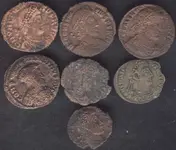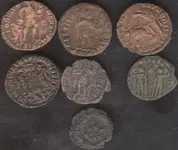JCinNJ
Full Member
- Joined
- Jan 25, 2008
- Messages
- 177
- Reaction score
- 2
- Golden Thread
- 0
- Location
- New Jersey
- Detector(s) used
- Whites XLT
Hi All,
This is my first post here (I Think). I enjoy reading about all of your finds especially the old silver caches. I hunt mainly on the beaches in New Jersey but I have hit a few parks, farms and yards. I was one of the vice presidents of Deep Search Metal Detecting Club but a few years back I took a new job and I always seem to be traveling on the dates the monthly meetings fall on.
These are a few of the uncleaned coins I bought on Ebay a few years back for $.50 each. These are the 17-18 mm size and ones I have been able to identify down to emperor and mint. I had soaked them for ages in olive oil, baked them in the oven everything and had no luck. They languished in my closet for a few years before I decided to try electrolysis. These coins were all about three times as thick as a dime and thoroughly encrusted even after the oil oil and baking.
They are all pretty common but a neat bit of history the same. There's even one Constantine the Great but mostly they are his sons and relatives.
Happy Hunting,
Joe
Examples Identified
AE3 of Gratian (367-383 AD.) DN GRATIANVS PF AVG facing right. Soldier dragging barbarian, holding labarum, GLORIA ROMANORVM, SISCE in the ex. Labarum' is the term for a standard bearing the Christian symbol Chi-Rho. This type is the most commonly available Roman coin that shows this symbol.
AE3 1/2 centenionalis (18mm) of Constantius II as Augustus (337-360 AD). DN CONSTANTIVS PF AVG, Constantius facing right / FEL TEMP REPARATIO reverse, with a soldier spearing barbarian horseman. BSIRM in ex.
AE3 of Constantine I (A.D. 320) 19mm
CONS-TANTINVS AVG high crested helmet (bowl shaped), cuirassed
VICTORIAE LAET PRINC PERP Joyous (well-earned) victory to the eternal Prince] two Victories standing., facing one another, together holding shield inscribed VOT PR [VOTA POPULI ROMANI (vows of the Roman people)]on altar. in ex. P 2 captives L RIC VII Lyons 79 c1
AE3 of Constantine the Great AE3. 335-336 AD Or Constantine II AE3/4. 337-340 AD (Probable). CONSTANTI-NVS MAX AVG, diademed, draped & cuirassed bust right / GLOR-IA EXERC-ITVS, two soldiers standing to the front, their heads turned inward gazing at standard bearing the Chi-Rho between them, each of their bear a spear and shield, ASIS in ex. Single standard coins bearing the name CONSTANTINVS were issued both for Constantine I and Constantine II as Augustus.. The easy (but not always accurate) answer is that the father was considerably older and more muscular than the son. This is not always shown well on the coins. The other two sons can be separated by their names.
AE4 - Constans AE4. 347-348 AD. DN CONSTANS PF AVG, diademed bust right / VOT XX MVLT XXX in wreath, SMKA in ex.
AE3 Constantius II (337-360 AD). 16mm. D N CONSTAN-TIVS P F AVG, pearl diademed, draped, cuirassed bust right / SPES REI-PVBLICE: Emperor helmeted, in military dress standing left holding globe & spear.
AE3 of Valentinian (364-375 AD). DN VALENTINIANVS PF AVG, Valentinian facing right / RESTITVTOR REIP, Valentinian standing, holding labarum and a globe with Victory. TESB in exergue.
Or possibly
AE3. of Valens (367- 370 AD) DN VALEN-S PF AVG, pearl diademed, draped, cuirassed bust right / RESTITV-TOR REIP, Valens facing, head right, holding labarum and Victory on a globe. Mintmark: TESB
AVG – Augustus – literally emperor
DN – Our lord
FEL TEMP REPARATIO – “Restoration of Happy Times” or “Happy Days are here again!”
GLORIA EXERCITVS (Glory of the Army).
GLORIA ROMANORVM – “The glory of Rome” or “Of the Romans”
PF = Pius Felix (Pious and Happy in a sense of 'blessed' more than 'jolly')
PP – Pater Patriae Father of his country
RESTITVTOR ORBIS – Restitutor or ruler of the world
SPES REIPVBLICE ('Hope of the Republic')
Mint Marks
BSIRM – Sirmium, now Sremska Mitrovica in Serbia
SISC – Siscily
L – Lugdunum, now Lyon, France
TES - Thessalonica
Did ya know? Ancient Romans in NJ? A collection of Roman coins found by Nelson Jecas which he found while metal detecting about six years ago in New Jersey. They date back to about 800 A.D. There are also some Roman coins in the Barnegat Light museum that were found on the beach years ago. Did they beat Columbus here by a few hundred years?
This is my first post here (I Think). I enjoy reading about all of your finds especially the old silver caches. I hunt mainly on the beaches in New Jersey but I have hit a few parks, farms and yards. I was one of the vice presidents of Deep Search Metal Detecting Club but a few years back I took a new job and I always seem to be traveling on the dates the monthly meetings fall on.
These are a few of the uncleaned coins I bought on Ebay a few years back for $.50 each. These are the 17-18 mm size and ones I have been able to identify down to emperor and mint. I had soaked them for ages in olive oil, baked them in the oven everything and had no luck. They languished in my closet for a few years before I decided to try electrolysis. These coins were all about three times as thick as a dime and thoroughly encrusted even after the oil oil and baking.
They are all pretty common but a neat bit of history the same. There's even one Constantine the Great but mostly they are his sons and relatives.
Happy Hunting,
Joe
Examples Identified
AE3 of Gratian (367-383 AD.) DN GRATIANVS PF AVG facing right. Soldier dragging barbarian, holding labarum, GLORIA ROMANORVM, SISCE in the ex. Labarum' is the term for a standard bearing the Christian symbol Chi-Rho. This type is the most commonly available Roman coin that shows this symbol.
AE3 1/2 centenionalis (18mm) of Constantius II as Augustus (337-360 AD). DN CONSTANTIVS PF AVG, Constantius facing right / FEL TEMP REPARATIO reverse, with a soldier spearing barbarian horseman. BSIRM in ex.
AE3 of Constantine I (A.D. 320) 19mm
CONS-TANTINVS AVG high crested helmet (bowl shaped), cuirassed
VICTORIAE LAET PRINC PERP Joyous (well-earned) victory to the eternal Prince] two Victories standing., facing one another, together holding shield inscribed VOT PR [VOTA POPULI ROMANI (vows of the Roman people)]on altar. in ex. P 2 captives L RIC VII Lyons 79 c1
AE3 of Constantine the Great AE3. 335-336 AD Or Constantine II AE3/4. 337-340 AD (Probable). CONSTANTI-NVS MAX AVG, diademed, draped & cuirassed bust right / GLOR-IA EXERC-ITVS, two soldiers standing to the front, their heads turned inward gazing at standard bearing the Chi-Rho between them, each of their bear a spear and shield, ASIS in ex. Single standard coins bearing the name CONSTANTINVS were issued both for Constantine I and Constantine II as Augustus.. The easy (but not always accurate) answer is that the father was considerably older and more muscular than the son. This is not always shown well on the coins. The other two sons can be separated by their names.
AE4 - Constans AE4. 347-348 AD. DN CONSTANS PF AVG, diademed bust right / VOT XX MVLT XXX in wreath, SMKA in ex.
AE3 Constantius II (337-360 AD). 16mm. D N CONSTAN-TIVS P F AVG, pearl diademed, draped, cuirassed bust right / SPES REI-PVBLICE: Emperor helmeted, in military dress standing left holding globe & spear.
AE3 of Valentinian (364-375 AD). DN VALENTINIANVS PF AVG, Valentinian facing right / RESTITVTOR REIP, Valentinian standing, holding labarum and a globe with Victory. TESB in exergue.
Or possibly
AE3. of Valens (367- 370 AD) DN VALEN-S PF AVG, pearl diademed, draped, cuirassed bust right / RESTITV-TOR REIP, Valens facing, head right, holding labarum and Victory on a globe. Mintmark: TESB
AVG – Augustus – literally emperor
DN – Our lord
FEL TEMP REPARATIO – “Restoration of Happy Times” or “Happy Days are here again!”
GLORIA EXERCITVS (Glory of the Army).
GLORIA ROMANORVM – “The glory of Rome” or “Of the Romans”
PF = Pius Felix (Pious and Happy in a sense of 'blessed' more than 'jolly')
PP – Pater Patriae Father of his country
RESTITVTOR ORBIS – Restitutor or ruler of the world
SPES REIPVBLICE ('Hope of the Republic')
Mint Marks
BSIRM – Sirmium, now Sremska Mitrovica in Serbia
SISC – Siscily
L – Lugdunum, now Lyon, France
TES - Thessalonica
Did ya know? Ancient Romans in NJ? A collection of Roman coins found by Nelson Jecas which he found while metal detecting about six years ago in New Jersey. They date back to about 800 A.D. There are also some Roman coins in the Barnegat Light museum that were found on the beach years ago. Did they beat Columbus here by a few hundred years?
Attachments
Upvote
0






